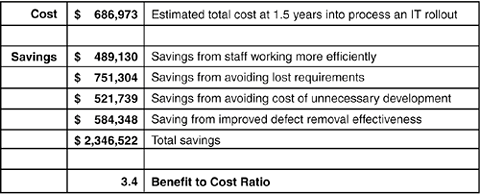Bottom Line: Benefit to Cost Ratio
| All that is left is to tally the benefit to cost ratio. As shown in Figure 7.15, the benefit to cost ratio for this particular case study1.5 years into the tool and process rolloutis 3.4 to 1, meaning that for every dollar spent you estimate that 3.4 dollars were saved. Figure 7.15. Benefit to cost ratio.
Recall that cost at this point includes one-time expenses, such as initial software purchase and initial on-site consulting and training, so the benefit to cost ratio should improve over time with those one-time expenses out of the way. On the other side of the equation, any future ROI models would need to take into account costs of ongoing maintenance of the tool and process (e.g., IT staff to support the tool, training for new employees, and so on). I'll re-emphasize what I mentioned earlier: the main point of this chapter is to describe how to build an ROI model for tool support of use case CM, not the results of this particular case study. I suggest taking this model only as a starting point, extending what it covers in terms of costs and benefits and calibrating the model with data from your company and industry. As they say, "Your mileage may vary." |
EAN: 2147483647
Pages: 109
